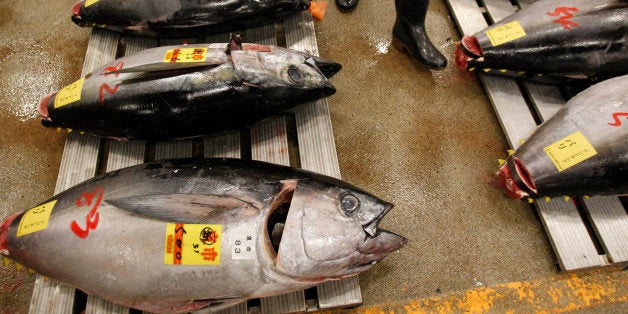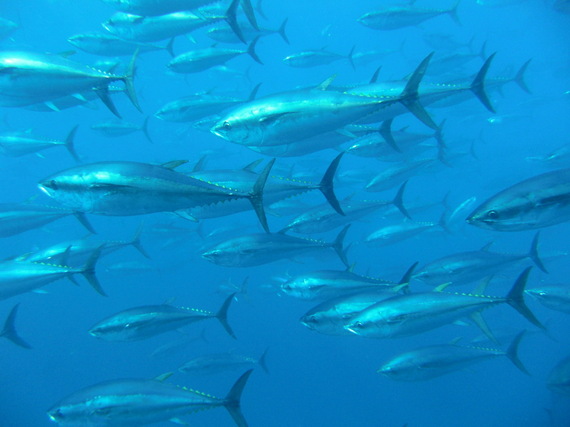

Bluefin Tuna, photo credit Tom Puchner, 2008 via Creative Commons
Bluefin tuna is one of the ocean's most prized fish, an icon of both modern and classic civilizations and a key predator in the ocean's delicate food chain. And yet its very existence on this planet is now up to us -- the collaborative actions of this generation's policymakers, fishermen, scientists, tech innovators, seafood industry leaders and communities. The survival of this majestic fish is on the brink, and we no longer have even a minute to waste.
How did we get here?
Since the early 1970s, the global bluefin population -- including its three sub-species of Atlantic, Pacific and Southern bluefin -- has declined by 80 percent, according to the International Commission for the Conservation of Atlantic Tunas (ICCAT). And the Pacific bluefin, specifically, is down to only 5 percent of its population size a century ago. In 2013, bluefin tuna represented just one percent of the world's tuna catch.
I participated earlier this month in an urgent gathering of stakeholders on this issue at the Bluefin Futures Symposium hosted by the Monterey Bay Aquarium and Stanford University. I was encouraged to see the three-day working meeting bring together scientists, policy makers and -- of vital importance -- the fishermen themselves to talk about how we might approach new solutions to this issue.
The meeting underscored the fact that saving the bluefin is a unique global challenge, one where the behavior of the species itself exemplifies the current limitations of being able to sustainably manage its catch. They know no boundaries.
Bluefin tuna are fast. And they are world travelers -- capable of spanning the globe in a calendar year. As a result, they are difficult to track and difficult to manage within specific economic zones or jurisdictions on the high seas. Fishers of Pacific bluefin, for example, are increasingly targeting juveniles -- to then fatten in aquaculture pens -- as well as trawling spawning locations where the fish can be reliably expected to congregate in greater numbers.
The result: both fewer developing adults and fewer offspring from current mature adults. This is the definition of unsustainable.
But there is hope.
There is another way. I know from personal experience. The Mediterranean offers us a glimpse. In the years I served as EU Commissioner for Maritime Affairs and Fisheries, we were able to achieve a new path for the Atlantic bluefin and other key commodity fish through collaboration with motivated nations, fishers and communities. These were solutions built incrementally on a foundation of compromise and points of shared interest. Not all of the challenges in the Mediterranean are solved. But the region is making progress.
This is our chance. As I shared at the symposium in Monterey, there are five essential elements to making progress for the Bluefin globally.
•Partner with fishermen and industry to create models of reform that demonstrate that sustainably-oriented fishing practices are economically viable. This is about survival of their livelihood. Only with their involvement and support will we make the progress we need.
•Use science to develop low-cost assessment methods for unassessed fisheries, and do collaborative research with fishermen to improve fishing gear so that it does less damage to habitats and non-target species.
•Use on-the-water projects to shape regional, national and local policies that move fisheries from open access toward coordinated rights-based management.
•Develop and use innovative technology to trace sustainably-caught fish from bait to plate, get market recognition and eliminate "lack of sufficient data" as the classic excuse for inaction.
•Create partnerships with up-front supply chain actors (producers, processors and distributors) and with certification labels to increase the number of sustainable fisheries in the market place.
And, to drive action across these elements, we will also need the commitment of communities and individuals who can motivate with their voices and their wallets.
Together, it's a complex combination of solutions. But it's the only way progress will be made at the needed scale.
Earlier this year, a single Pacific bluefin tuna sold for US $118,000 at the annual ritualized auction in Tokyo's Tsukiji market. Restaurant owners bid each other up for the honor of claiming the first catch of the year. It's a symbol of the cultural power of the species. But it's also a symbol of the perils of an unsustainable market.
At this point, all stakeholders in the seafood economy should recognize that, on our current path, these are bids not on the first catch, but on one of the last. And, to change that story must be our shared responsibility.
Maria Damanaki (@damanaki) is Global Managing Director for Oceans at The Nature Conservancy. See her latest thinking at nature.org/global.